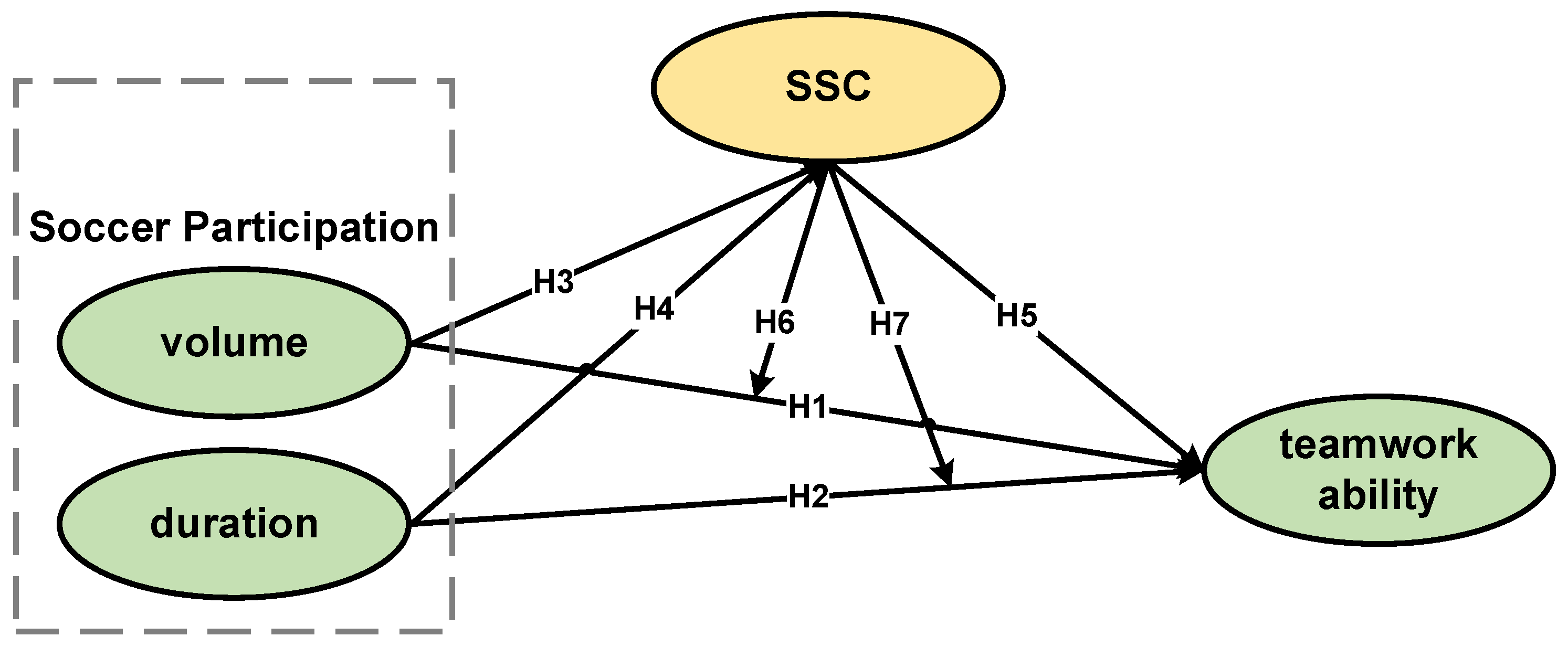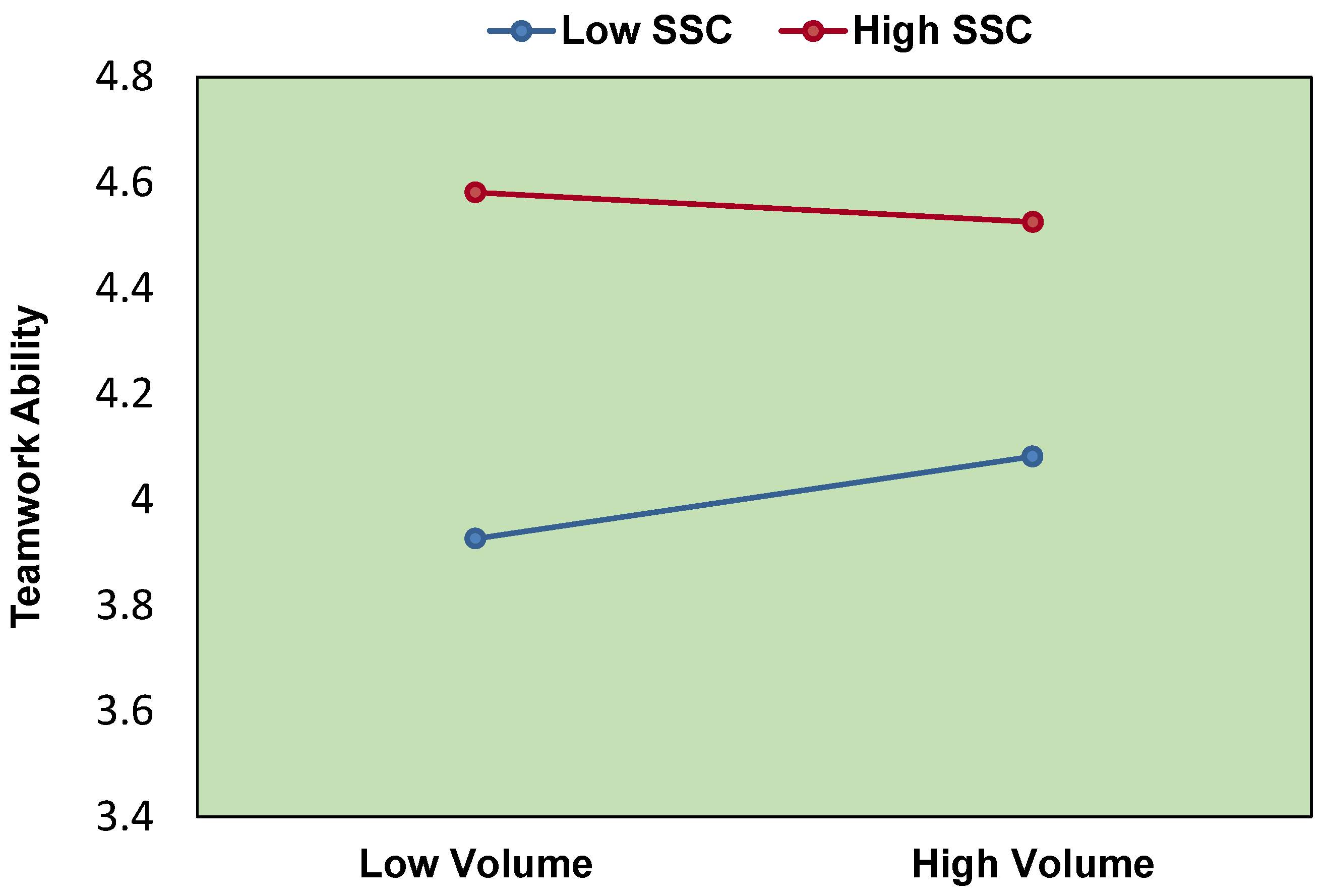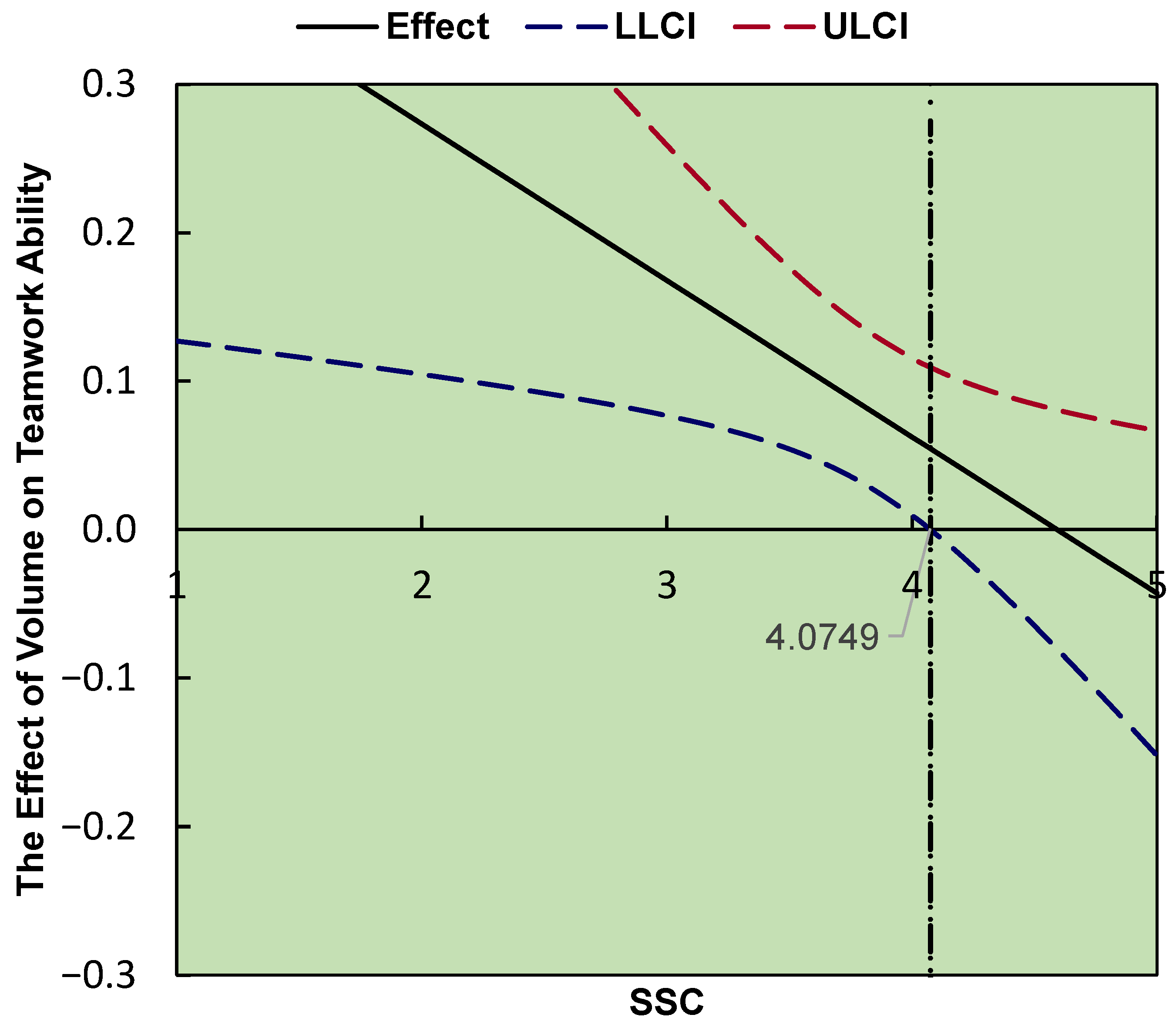The Moderating Role of Sociability and Social Connection for the Relationship between Soccer Participation and Teamwork Ability among Chinese College Students
Abstract
1. Introduction
2. Materials and Methods
2.1. Measures
2.1.1. Soccer Participation
2.1.2. Teamwork Ability
2.1.3. Sociability and Social Connection
2.2. Participants and Procedure
3. Results
3.1. Descriptive Statistics and Correlations
3.2. Moderating Effect of SSC
3.3. Comparison of Collegiate Soccer Athletes and Collegiate Soccer Participants
4. Discussion
5. Conclusions
Author Contributions
Funding
Informed Consent Statement
Data Availability Statement
Conflicts of Interest
References
- Britton, E.; Simper, N.; Leger, A.; Stephenson, J. Assessing teamwork in undergraduate education: A measurement tool to evaluate individual teamwork skills. Assess. Eval. High. Educ. 2017, 42, 378–397. [Google Scholar] [CrossRef]
- Murnane, R.J.; Levy, F. The New Division of Labor: How Computers Are Creating the Next Job Market; Princeton University Press: Princeton, NJ, USA, 2012. [Google Scholar]
- D’Isanto, T.; Aliberti, S.; Altavilla, G.; Esposito, G.; D’Elia, F. Heuristic Learning as a Method for Improving Students’ Teamwork Skills in Physical Education. Int. J. Environ. Res. Public Health 2022, 19, 12596. [Google Scholar] [CrossRef] [PubMed]
- Dede, C. Comparing frameworks for 21st century skills. In 21st Century Skills: Rethinking How Students Learn; Solution Tree Press: Bloomington, IN, USA, 2010; Volume 20, pp. 51–76. [Google Scholar]
- Salas, E.; Cooke, N.J.; Rosen, M.A. On teams, teamwork, and team performance: Discoveries and developments. Hum. Factors 2008, 50, 540–547. [Google Scholar] [CrossRef] [PubMed]
- Hughes, R.L.; Jones, S.K. Developing and assessing college student teamwork skills. New Dir. Inst. Res. 2011, 2011, 53–64. [Google Scholar] [CrossRef]
- Wilson, L.; Ho, S.; Brookes, R.H. Student perceptions of teamwork within assessment tasks in undergraduate science degrees. Assess. Eval. High. Educ. 2018, 43, 786–799. [Google Scholar] [CrossRef]
- Halldorsson, V.; Thorlindsson, T.; Katovich, M.A. Teamwork in sport: A sociological analysis. Sport Soc. 2017, 20, 1281–1296. [Google Scholar] [CrossRef]
- Duch, J.; Waitzman, J.S.; Amaral, L.A.N. Quantifying the Performance of Individual Players in a Team Activity. PLoS ONE 2010, 5, e10937. [Google Scholar] [CrossRef] [PubMed]
- Van Raalte, J.L.; Brewer, B.W. Why Wasn’t Sport Included? Comment on the Special Issue on the Science of Teamwork (2018). Am. Psychol. 2019, 74, 252–253. [Google Scholar] [CrossRef] [PubMed]
- Zhang, X.J. Teams in Jiangsu colleges current situation and countermeasures regarding the training mode of high-level soccer. J. Soochow Univ. (Nat. Sci. Ed.) 2011, 27, 90–94. [Google Scholar]
- Au-Yong-Oliveira, M.; Ferreira, J.J.P.; Gouveia, J.B. Leading for Team Synergy–The Challenge of Getting Extremely Talented Individuals to Work Together. In Proceedings of the 7th Annual Conference of the EuroMed Academy of Business, Kristiansand, Norway, 18–19 September 2014; pp. 171–177. [Google Scholar]
- McEwan, D.; Beauchamp, M.R. Teamwork in sport: A theoretical and integrative review. Int. Rev. Sport Exerc. Psychol. 2014, 7, 229–250. [Google Scholar] [CrossRef]
- Gaffney, P. The Nature and Meaning of Teamwork. J. Philos. Sport 2015, 42, 1–22. [Google Scholar] [CrossRef]
- Skultety, S. Categories of Competition. Sport Ethics Philos. 2011, 5, 433–446. [Google Scholar] [CrossRef]
- Garcia-Calvo, T.; Leo, F.M.; Gonzalez-Ponce, I.; Sanchez-Miguel, P.A.; Mouratidis, A.; Ntoumanis, N. Perceived coach-created and peer-created motivational climates and their associations with team cohesion and athlete satisfaction: Evidence from a longitudinal study. J. Sport. Sci. 2014, 32, 1738–1750. [Google Scholar] [CrossRef]
- Fominiene, V.B.; Jeseviciute-Ufartiene, L. The Interface between the Employee Attitude to Teamwork and Communication Skills: Example of Sport Clubs. Transform. Bus. Econ. 2016, 15, 672–685. [Google Scholar]
- Stevens, M.J.; Campion, M.A. The Knowledge, Skill, and Ability Requirements for Teamwork–Implications for Human-Resource Management. J. Manag. 1994, 20, 503–530. [Google Scholar] [CrossRef]
- Cao, M.; Wang, T.; Zhai, Q.Q.; Jin, Y. Effect of ISBAR Communication Training Model on Communication Skills and Teamwork Ability of General Practitioners Participating in Standardized Residency Training. Chin. Gen. Pract. 2020, 23, 2062–2066. [Google Scholar]
- Liu, K.K.; Xu, R.; Fan, X.Z.; Hao, Y.L.; Zhang, L.N. Research on the correlation between teamwork ability, interpersonal communication and coordination ability, and critical thinking ability. China High. Med. Educ. 2015, 4, 31–33. [Google Scholar]
- Symvoulakis, E.K.; Linardakis, M.; Kamekis, A.; Morgan, M.; Klinis, S. The Personal Sociability and Connections Scale (PeSCS): Development and initial assessment at a primary care facility. Int. J. Soc. Psychiatry 2022, 68, 639–648. [Google Scholar] [CrossRef] [PubMed]
- Wilkinson, A.; Bowen, L.; Gustavsson, E.; Hakansson, S.; Littleton, N.; McCormick, J.; Thompson, M.; Mulligan, H. Maintenance and Development of Social Connection by People with Long-term Conditions: A Qualitative Study. Int. J. Environ. Res. Public Health 2019, 16, 1875. [Google Scholar] [CrossRef] [PubMed]
- Waytz, A.; Gray, K. Does Online Technology Make Us More or Less Sociable? A Preliminary Review and Call for Research. Perspect. Psychol. Sci. 2018, 13, 473–491. [Google Scholar] [CrossRef]
- Li, X.Y. Under the new situation to cultivate college students’ teamwork trial. J. Jiangsu Ocean Univ. (Humanit. Soc. Sci. Ed.) 2012, 10, 108–109. [Google Scholar]
- Devin, H.F.; Farbod, D. The Mediating Role of Coaches’ Sense of Humor in Relationship of Group Emotional Intelligence with Teamwork Effectiveness in Collegiate Athletes. New Armen. Med. J. 2017, 11, 29–38. [Google Scholar]
- Du, S.; Yin, j. Influencing Factors of individual Performance in leaderless group discussion: A study based on personality, values and team experience. J. Nanjing Univ. (Philos. Humanit. Soc. Sci.) 2009, 46, 132–141. [Google Scholar]
- Evans, B.; Eys, M.; Wolf, S. Exploring the Nature of Interpersonal Influence in Elite Individual Sport Teams. J. Appl. Sport Psychol. 2013, 25, 448–462. [Google Scholar] [CrossRef]
- Ding, Y.; Yan, Y.H. Teamwork competence training methodology study. Hum. Resour. Dev. China 2009, 9, 10–13. [Google Scholar] [CrossRef]
- Stoica, D.; Barbu, D. The Influence of Football Game in the Socialization of Students from High Schools with Sports Major Profile. In Proceedings of the 4th International Congress of Physical Education, Sport and Kinetotherapy (Icpesk 2014), Bucharest Romania, 11–13 June 2014; Medimond Publishing Company: Bologna, Italy, 2015; pp. 483–490. [Google Scholar]
- Park, S.; Park, J.; Yoo, J.; Jee, Y.S. Effect of playing soccer on stress, sociality, and physical fitness in alienated youth: A retrospective study. J. Exerc. Rehabil. 2020, 16, 154–161. [Google Scholar] [CrossRef] [PubMed]
- Lee, M.-S.; Jung, S.-H. The effect of physical activity with peer competence for children. J. Korea Acad.-Ind. Coop. Soc. 2014, 15, 883–890. [Google Scholar] [CrossRef]
- Hou, X.H. Research on the Value of the Youth Football Program at School in China. J. Beijing Sport Univ. 2012, 35, 77–83. [Google Scholar] [CrossRef]
- Shen, M.; Tang, J.Y.; Li, P. An experimental study on the promotion of college student mental health by football sports. In Proceedings of the 6th Chinese football culture and campus Football Development Conference 2022, Huaibei, China, 24 August 2022; p. 409. [Google Scholar]
- Liang, D.Q. The stress level of college students and its relationship with physical exercise. Chin. Ment. Health J. 1994, 8, 5–6. [Google Scholar]
- Liu, Y.T.; Wang, Z.Y.; You, S.H. The Mediating Effect of Coping Style on Physical Activity and Negative Affect Caused by Public Health Emergencies: Evidence from Chinese College Students. Int. J. Environ. Res. Public Health 2021, 18, 12086. [Google Scholar] [CrossRef]
- Podsakoff, P.M.; MacKenzie, S.B.; Lee, J.Y.; Podsakoff, N.P. Common method biases in behavioral research: A critical review of the literature and recommended remedies. J. Appl. Psychol. 2003, 88, 879–903. [Google Scholar] [CrossRef] [PubMed]
- Hayes, A.F.; Rockwood, N.J. Regression-based statistical mediation and moderation analysis in clinical research: Observations, recommendations, and implementation. Behav. Res. Ther. 2017, 98, 39–57. [Google Scholar] [CrossRef] [PubMed]
- Hayes, A.F.; Montoya, A.K. A Tutorial on Testing, Visualizing, and Probing an Interaction Involving a Multicategorical Variable in Linear Regression Analysis. Commun. Methods Meas. 2017, 11, 1–30. [Google Scholar] [CrossRef]
- Preacher, K.J.; Rucker, D.D.; Hayes, A.F. Addressing moderated mediation hypotheses: Theory, methods, and prescriptions. Multivar. Behav. Res. 2007, 42, 185–227. [Google Scholar] [CrossRef]
- Lang, J.; Yang, G.Q.; Wang, C.Q. Present Situation of the Development of Chinese Women’s Football Movements. J. Shenyang Sport Univ. 2006, 25, 100–101. [Google Scholar]
- Zhong, W.Z. Investigation and analysis of the current situation of Chinese college futsal players. Bull. Sport Sci. Technol. 2008, 4, 24–25+51. [Google Scholar]
- Lan, B.S.; Hou, H.S. Study on Athletic Anxiety and Relevant Element of College Students Soccer Man Players. J. Beijing Sport Univ. 2010, 33, 64–67. [Google Scholar] [CrossRef]




| Variable | M | SD | Correlations | |||
|---|---|---|---|---|---|---|
| 1 | 2 | 3 | 4 | |||
| 1. volume | 1.893 | 1.007 | 1 | |||
| 2. duration | 2.120 | 1.503 | 0.811 ** | 1 | ||
| 3. SSC | 3.857 | 0.612 | 0.079 | 0.060 | 1 | |
| 4. teamwork ability | 3.999 | 0.712 | 0.145 ** | 0.120 ** | 0.484 ** | 1 |
| Variable | Teamwork Ability | Teamwork Ability | ||
|---|---|---|---|---|
| β | t | β | t | |
| Gender | 0.008 | 0.184 | 0.057 | 1.520 |
| volume | 0.717 | 2.961 ** | ||
| SSC | 0.654 | 8.298 *** | ||
| volume × SSC | −0.649 | −2.527 * | ||
| F | 0.034 | 46.599 | ||
| R2 | 0.000 | 0.257 | ||
Publisher’s Note: MDPI stays neutral with regard to jurisdictional claims in published maps and institutional affiliations. |
© 2022 by the authors. Licensee MDPI, Basel, Switzerland. This article is an open access article distributed under the terms and conditions of the Creative Commons Attribution (CC BY) license (https://creativecommons.org/licenses/by/4.0/).
Share and Cite
Liu, Y.; You, S.; Wang, Z. The Moderating Role of Sociability and Social Connection for the Relationship between Soccer Participation and Teamwork Ability among Chinese College Students. Int. J. Environ. Res. Public Health 2022, 19, 15441. https://doi.org/10.3390/ijerph192315441
Liu Y, You S, Wang Z. The Moderating Role of Sociability and Social Connection for the Relationship between Soccer Participation and Teamwork Ability among Chinese College Students. International Journal of Environmental Research and Public Health. 2022; 19(23):15441. https://doi.org/10.3390/ijerph192315441
Chicago/Turabian StyleLiu, Yuetao, Songhui You, and Zhiyuan Wang. 2022. "The Moderating Role of Sociability and Social Connection for the Relationship between Soccer Participation and Teamwork Ability among Chinese College Students" International Journal of Environmental Research and Public Health 19, no. 23: 15441. https://doi.org/10.3390/ijerph192315441
APA StyleLiu, Y., You, S., & Wang, Z. (2022). The Moderating Role of Sociability and Social Connection for the Relationship between Soccer Participation and Teamwork Ability among Chinese College Students. International Journal of Environmental Research and Public Health, 19(23), 15441. https://doi.org/10.3390/ijerph192315441







